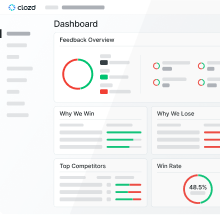TL;DR
- Buyer-centric data is critical for marketing leaders to inform marketing strategies and prioritize programs that drive tangible results.
- Win-loss analysis helps optimize go-to-market motions, drive clear business outcomes, and foster cross-functional collaboration.
- Utilize win-loss insights to understand buyer behavior, improve messaging, and enhance down-funnel conversion.
- Build cross-functional alignment by sharing insights; collaborating with sales, customer success, and product teams; and prioritizing initiatives based on data.
- By focusing on buyer feedback, marketing leaders can drive meaningful change and strengthen internal alignment.
Today’s marketing leaders navigate continued economic disruption, funding challenges, and changing buyer preferences as they work to achieve sustained growth.
In this dynamic landscape, buyer-centric data is critical to informing marketing strategies and prioritizing programs that drive tangible results. Through win-loss analysis, marketing leaders can better optimize their go-to-market motions, use data to drive clear business outcomes, and collaborate cross-functionally to deliver organization-wide change.
Why does win-loss analysis matter to marketing leaders?
In a former role, I partnered closely with my sales counterpart to ensure that our respective sales and marketing teams achieved their pipeline and revenue targets.
Over time, we noticed a consistent pattern: Although we routinely exceeded our pipeline goals, we rarely hit our revenue targets. To find the underlying cause, we pulled CRM data, polled the sales team, and interviewed sales leaders.
The data and internal feedback were inconsistent, and we were unsuccessful in finding the root cause until we reviewed the data we captured through win-loss analysis. Through that direct buyer feedback, we determined that significant gaps in the sales process were inhibiting the buyer experience. As a result of our findings, we invested in additional training and enablement to close the gap.
This lesson became a foundational principle for our team: Buyer feedback should be the source of truth to uncover key insights and plan accordingly.
How can your marketing team utilize win-loss insights?
As a marketing leader, win-loss data is fundamental to my team’s strategy.
We optimize our go-to-market motion by better understanding buyer behavior and Decision Drivers. We’re able to deliver better messaging that highlights buyer-perceived strengths and combats perceived weaknesses. And, as in the example above, we improve down-funnel conversion by uncovering specific sales patterns.
 |
At Clozd, we recently decided to rebrand. When our marketing team kicked off the project, we first turned to our own win-loss data to inform our brand strategy, evaluate our reputation, and develop our new messaging and web experience. That win-loss feedback enabled us to deliver a stronger brand experience that’s built on a foundation of data.
Post-launch, we’ve continued to monitor brand perception and reputation through the lens of our buyer.
What are the best ways to build cross-functional alignment around win-loss insights?
Sharing insights from win-loss data across the organization is an ongoing practice at Clozd. Our marketing team regularly reviews data individually and during team meetings to ensure we have an up-to-date understanding of buyer feedback and to monitor trends.
We also work cross-functionally with peers in sales, customer success, and product to drive business outcomes. Each team consumes the insights that are relevant to their function, and we join forces to address the collective feedback.
For example, when we’re strategically building out our product roadmap, win-loss data is referenced to prioritize initiatives by the product team, to steer the GTM strategy and messaging from the marketing team, and to tailor enablement and training by the sales and customer success teams.
By democratizing our own win-loss data, we better engage key stakeholders and drive strategic alignment.
Buyer-centric data captured through win-loss analysis is quickly becoming a critical part of the marketing leader’s toolkit. By keeping a pulse on buyer sentiment, leaders can better prioritize initiatives that address perceived strengths and weaknesses, and strengthen internal alignment.
Customers are central to our business, and by focusing on the real reasons you win and lose, you can drive meaningful change with confidence.
For a personalized Clozd demo, sign up here.











.svg)











.svg)

.svg)




